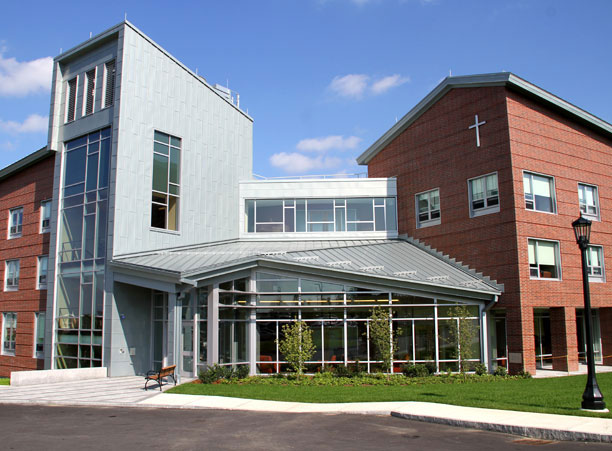Figge Hall, the newest residence hall at the College of the Holy Cross, has earned LEED Gold certification by the U.S. Green Building Council (USGBC), a national organization that certifies buildings that are green and sustainable, and protect the environment. It is the second LEED Gold certified project on campus. The Integrated Science Complex received the same designation in 2010.
Completed in 2011, the $19.2 million Figge Hall is a four-story, 60,000-square foot building, accommodating 156 seniors. The 39 apartments consist of a living room, dining area, full kitchen, bathroom and two bedrooms.
“As the second building on campus to receive LEED Gold certification, Figge Hall adheres to high standards of energy efficiency, and is an important example of the College’s continuing commitment to sustainability,” says Rev. Philip L. Boroughs, S.J., president of the College. “In addition to exceeding our goal to reduce carbon emissions by 20 percent by 2015 ahead of schedule, the Holy Cross community is heavily vested in reducing its carbon footprint and reaching carbon neutrality.”
“We are thrilled Figge Hall is the first residence hall on campus to receive such high marks from the U.S. Green Building Council,” says Scott Merrill, director of physical plant. “The residence hall is distinctive in its use of quality, environmentally-friendly elements. It utilizes 50 percent less water than other buildings its size; incorporates recycled materials throughout the building process; and was intentionally built with a constant focus on energy efficiency.”
The residence hall is named in honor of John K. Figge ’59 (1938-2009), a former member of the Board of Trustees.
CBT Architects and RDK Engineers incorporated high energy efficiency standards in all phases of design and construction. Sustainable highlights include:
- Low-flow fixtures make major contributions to water savings with an estimated 50 percent water use reduction compared to conventional fixtures.
- Occupancy sensors are installed in corridors, common rooms and bedrooms. Sensors turn off the lights automatically when people leave the areas to help reduce energy consumption when building activity is minimal. Large windows allow for ample natural light, reducing the need for artificial lighting loads.
- The heating and cooling system includes condensing boilers with efficiency greater than 90 percent. Each unit has an enthalpy wheel that allows you to preheat or pre cool the outdoor air used for ventilation with building exhaust air.
- Low-emitting carpets, paints, adhesives, and furnishings contribute to protecting the indoor air quality. Additionally, a green housekeeping program has been established that reduces waste, improves indoor air quality, and protects the environment from harmful cleaning chemicals.
- Regionally sourced and recycled content materials include many of the structural components of the building. Structural steel contains almost all recycled content at 99 percent, the curtain wall has more than 65 percent recycled content, the windows have more than 5 percent recycled content and the concrete is harvested locally in Massachusetts.
- The residence hall contains a secure interior bike storage room to encourage students to use an alternate means of transportation.
As part of the College’s participation in the American College and University Presidents Climate Commitment (ACUPCC), all new construction going forward on campus will be energy efficient and meet or exceed LEED silver standards.
Related Information:



